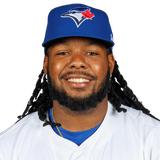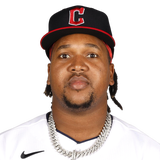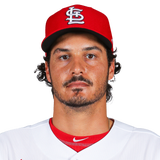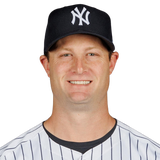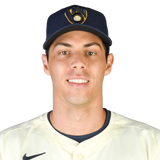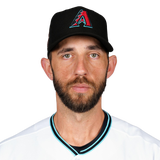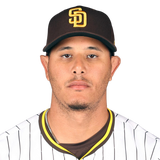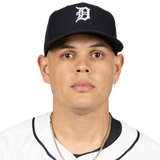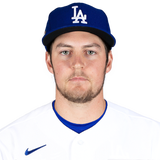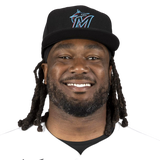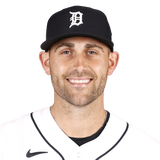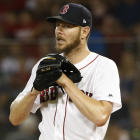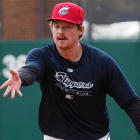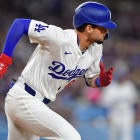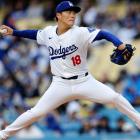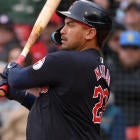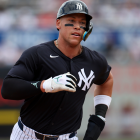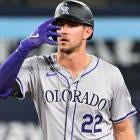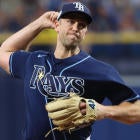So ... what's going on? Maybe it's been a while since you've thought about baseball. But you're here now, rubbing the cobwebs out of your eyes, poring over rankings and depth charts. Here's what you're really wondering, though: What's the buzz?
What are the big talking points? What is it everyone is worrying about, and should you be worried, too?
So here it is: a roundup of some of the biggest questions facing Fantasy Baseballers in 2020.
1) Is the ball still "juiced?"
The way we approach most every player — and, truly, the game itself — hinges on this all-too-mysterious issue, which has been met with mostly denials and conspiracy theories so far. These came to a head during the 2019 postseason, when all available data suggested the ball wasn't carrying like during the regular season. So MLB commissioned a study to address the issue once for all and concluded that an almost imperceptible change in seam height (0.001 inches) accounted for more than a third of the fluctuation in drag. This was a result of manufacturing variability — a side effect of all balls being stitched by hand — and not something MLB has direct control over.
The conspiracy theories remain, but MLB's stance suggests that any future changes to the ball's drag would be unintentional and, therefore, impossible to account for. Best, then, to put it out of your mind.
2) How should we handle Astros hitters?
Yup, they're cheaters. A sign-stealing scandal that involved an illegal camera feed and some creative use of trash cans in the dugout got their manager and GM fired. The investigation mostly focused on their World Series-winning 2017 season, though, and apart from some conspiratorial photos and videos on Twitter, there isn't much evidence it continued into 2019. Some fascinating research performed by an Astros fan, as well as a look at the home/away splits, suggests it wasn't terribly effective anyway, at least not on a macro level. When you consider most of the Astros' hitters were high-end prospects with impressive minor-league careers and/or established track records in the majors, it's probably much ado about nothing, at least from a pure production standpoint.
3) Will Vladimir Guerrero achieve liftoff?
| ||||||||||
The player I once described as the best pure hitting prospect I've ever seen had an underwhelming big-league debut, but there were flashes of his monstrous potential, such as the show he put on in the Home Run Derby and the fact three of the eight hardest-hit balls in all of 2019 belonged to him. The biggest issue is that he just didn't elevate, ranking 234th among the 250 qualifying players in average launch angle. MLB teams are pretty attuned to the stuff, though, and Juan Soto is a fine example of a player who dramatically improved his fly-ball rate from Year 1 to Year 2. Clearly, most Fantasy players are counting on something similar for Guerrero, drafting him as a top-50 player on average even though he plays arguably the deepest position.
4) Is Jose Ramirez really and truly back?
| ||||||||||
It's still hard to believe, given his stature in the game the past few years, that Ramirez had a near year-long stretch — from mid-August 2018 through early July 2019 — during which he hit .198 with eight home runs in 449 at-bats. But then, just as quickly as the lights went off, they came back on again, yielding a .326 batting average and 18 homers over his final 178 at-bats. The usual skill indicators that tell us whether a player is legit or not barely moved throughout the whole saga, which would suggest the bad stretch was just an extended slump — one that began as an ill-advised effort to beat the shift, according to deeper analytical dives and anecdotal evidence.
5) How will Carlos Carrasco hold up?
It's uncomfortable to talk about since I'm neither a doctor nor have endured an experience like Carrasco did in 2019, taking three months off in the middle of last season to battle leukemia — a form of cancer that resides in the bloodstream and, thus, can impact a patient's entire physiology. That Carrasco was able to come back and pitch out of the bullpen down the stretch was a relief in so many ways, and his velocity was fine during that time. But will he still have the endurance to maintain it over six-plus innings as in years past? He'll go later than in the past as a result, albeit still alongside potential aces like Sonny Gray and Frankie Montas.
6) Will we ever know what to do with Shohei Ohtani?
So far across two major-league seasons, Ohtani has shown that he's able to pitch and hit at a high level, but he hasn't shown that he's able to do both at the same time. Obviously, being unable to take the mound for all of 2019 impeded that goal, but we still don't know when exactly he'll return to pitching after having Tommy John surgery. It's what those who draft him will need him to do the most, but given that he probably won't be on a typical five-day schedule and will need some days off from hitting as well, will you be able to count on him in a league with weekly lineups? At least in CBS Sports leagues, you have to commit to either the hitting stats or the pitching stats at the start of each week, but it seems like some weeks you might choose to sit him altogether.
7) Can Edwin Diaz be a lights-out closer again?
Remember how a change in seam height was contributing to the so-called "juiced ball?" There's a theory it also impacted Diaz's slider (as well as Masahiro Tanaka's splitter), rendering his best weapon at times more of a liability. He still piled up whiffs with it, but his home run rate exploded, resulting in a 5.59 ERA that defied his 3.07 xFIP. It would seem, then, that a few glaring mistakes sabotaged what was otherwise a killer arsenal. Whether or not he can compensate for the slickness of the ball (assuming the ball doesn't change) remains to be seen, and the Mets do have a reasonable alternative in Seth Lugo. But boy is the price tag lower now for what was the consensus No. 1 reliever at this time a year ago.
8) Do Nolan Arenado and Kris Bryant stick around?
| ||||||||||
Anytime a star player is moved, reverberations are felt throughout the entire baseball world, including Fantasy, so when and where Bryant is moved, assuming it happens at all, is certainly an item of interest. But an Arenado deal would be a bigger deal to Fantasy players — and is perhaps more likely after the 28-year-old said he felt "disrespected" by the organization this offseason. His caliber of bat — big power with a low strikeout rate — would of course be a factor anywhere, but it probably comes as no surprise that he has typically fared better in the thin-air environment of Coors Field, batting .277 with an .866 OPS on the road last year and .265 with a .799 OPS there for his career.
9) How will Gerrit Cole handle his transition?
| ||||||||||
The most vengeful of us will be tempted to reduce Cole's transformation with the Astros to some nefarious plan cooked up by an organization now infamous for them, and that theory would be easier to entertain in a world where Charlie Morton doesn't exist. But pitch selection was at the heart of most every one of the pitchers the Astros reformed, backed up by data that already existed. Cole's heights exceeded all of the others' because his talent level also did, being a former first overall pick, and as the game's preeminent strikeout pitcher now full accustomed to an ace workload, he's equipped to succeed anywhere. His ERA might go up a little being a fly-ball pitcher at Yankee Stadium, but not enough to make him unworthy of a first-round pick.
10) Will Christian Yelich feel any adverse effects from his fractured kneecap?
| ||||||||||
If it's a question people are asking, it's not reflected in the ADP data, which shows Yelich going third overall. And I'm not here to say he shouldn't. The bat alone the past two years is enough to justify it, and the bat probably won't be what suffers with this injury. But Jose Altuve fractured his kneecap at some point during the 2018 season and has basically stopped running ever since. Maybe it was simply a choice — Statcast still awards him high ratings for sprint speed — but it's a choice the Brewers may well also make to protect their franchise player. Don't go assuming you have a head start in steals if you land Yelich in Round 1.
11) How will Madison Bumgarner manage away from Oracle Park?
| ||||||||||
The numbers are greatly concerning entering his first year in Arizona. Bumgarner obviously hasn't been the same since spraining his shoulder in a dirt bike accident early in 2017, but pitching in the game's most pitcher-friendly venue may have understated the decline. His home/away splits the past two years have veered toward the extreme — a 2.93 ERA and 0.93 WHIP at Oracle Park last year vs. 5.29 and 1.41 everywhere else and a 1.63 ERA and 1.04 WHIP there in 2018 vs. 4.97 and 1.45 everywhere else. It may not be as straightforward as all that, though, seeing as his cutter regained much of his velocity last year and his swinging-strike rate was actually his second-best ever. Play it cautiously, but don't bury him.
12) When will Jo Adell get the call?
Some early drafters seemed to be under the impression Adell could break camp with the big club and responded to the Angels' (ultimately failed) pursuit of Joc Pederson with doom and gloom. It never seemed like a realistic possibility, though, given how the 20-year-old struggled in his brief look at Triple-A late last year. It doesn't mean his future isn't bright or that he won't be up at some point in 2020, potentially contributing both power or speed, but it does mean he's just one of several exciting prospects who fit into that category. The upcharge (234th overall, according to FantasyPros) might be a little high considering.
13) Are the Dodgers all-in on Julio Urias?
| ||||||||||
The offseason had barely kicked off when president of baseball operations Andrew Friedman announced the Dodgers' intentions to move Urias to the starting rotation, having given him a year in a swingman role to prove he was up to the challenge. Apparently, they liked what they saw. It's a development years in the making after he surged to the majors as a 19-year-old phenom in 2016 only to suffer a shoulder capsule tear, requiring surgery and a lengthy rehabilitation. The Dodgers seem eager to get his career back on its intended course, but they still have a surplus of rotation options and are almost certain to limit his innings, likely to somewhere in the 120 range.
14) Will Yu Darvish's second-half gains hold?
| ||||||||||
Darvish didn't look himself for the eight starts he was healthy in 2018, and an inability to find the strike zone for half of 2019 raised concerns he'd never be himself again. But then it was like a switch flipped. He rediscovered his splitter, no longer had to rely so much on the slider, and suddenly couldn't miss. Like, literally — he had seven walks in his final 14 starts compared to 44 in his first 13. The overall numbers during that stretch were a 2.95 ERA, 0.83 WHIP and 12.6 K/9, and while it's unreasonable to think he can sustain quite that pace over a full season, he clearly has the stuff and pitch variety to dominate now that he's shaken off the rust.
15) Can Manny Machado cut it in San Diego?
| ||||||||||
We had an inkling Machado's production was venue-reliant given both his consistently favorable home splits over more than half a decade at hitter-friendly Camden Yards and the dip his numbers took after being traded to the Dodgers (basically looking like his typical road splits). But we were ill-prepared for how he might perform when plopped in a pitcher-friendly environment like Petco Park. Whoa, Nelly, was he bad there, batting .219 with a .703 OPS.
Granted, a breakdown of his career numbers by venue shows he hasn't been a dud at everything we might consider a pitcher's park, but a look at his batted-ball profile shows a consistently low line-drive rate and high fly-ball rate, making his batting average highly dependent on his home run total. He may get better in Year 2 in San Diego, but he probably won't become a first round-type hitter again.
16) How worried should we be about Corey Kluber?
Whenever a pitcher misses the majority of a season with an arm injury, it's cause for concern, and when the pitcher is in his mid-30s, that goes double. But in Kluber's case, it was a fractured forearm, not a ligament or anything muscular and not at an actual moving part. What ratcheted up concerns was the lowball return the Indians got from the Rangers at a time when high-end starting pitchers are an especially valuable asset. True, Kluber was bad in the seven starts prior to the injury last year, compiling a 5.80 ERA, but the same was true for many longtime aces as the league adjusted to the slicker, lower-seamed (i.e., "juiced") balls. Seeing as Kluber was a top-three Cy Young finisher three of the previous four years, the concerns are probably overblown.
17) How will the Yankees sort out their corner infield spots?
| ||||||||||
Too many cooks can spoil the broth, and that's where the Yankees find themselves with Miguel Andujar coming back from injury after a year when third baseman Gio Urshela and first baseman Luke Voit established themselves. Add a pinch of Mike Ford, who homered 12 times in 143 at-bats with some scintillating skill indicators, and this broth is about to boil over. It's not like any of these players is entirely proven, though. Maybe Andujar isn't the same coming off shoulder surgery, or maybe Luke Voit's second-half slump wasn't entirely related to his sports hernia. The one whose playing time seems most assured is Urshela, who has such a defensive advantage over Andujar at third base that it'd be silly for the Yankees not to stick with him there. Andujar was seeing some time in left field this spring, but Mike Tauchman makes for another possible obstacle there.
18) How long before the Rockies move on from Daniel Murphy and Ian Desmond?
As has been true for seemingly half a decade, the Rockies have a number of intriguing young bats that they don't seem motivated to play, blocking them with aging vets on bloated contracts. They've mostly turned the page on Desmond at least, pretty much just playing him against left-handers in September, but Murphy, whose hard-hit rate has plummeted the past two seasons, may not go as quietly. It's a shame, too, because Fantasy players are so eager to believe in Garrett Hampson, drafting him 164th overall, but he doesn't yet have an opening at second base, where Ryan McMahon will remain with Murphy occupying first. Outfield remains a possibility, but those at-bats would come at the expense of Sam Hilliard, a late-blooming 26-year-old who had a combined 42 homers and 24 steals between the majors and minors.
19) Park factors: How will the new dimensions play in San Francisco and Miami? What about the new stadium in Texas?
Yes, the two most pitcher-friendly venues in baseball are getting a facelift, both to the benefit of hitters. The changes to Oracle Park in San Francisco are mostly to relocate the bullpens behind the outfield fence and, therefore, may not end up helping hitters as much as we may hope, but balls hit to center field, where the fences are now eight feet closer, only 391 feet, have a better chance of leaving the yard than at most parks. But "Triples Alley," where the center field fence meets the brick wall in right-center, is still extreme, down from 421 to 415, and the fences will only be five feet closer in left-center as well. A hitter like Mike Yastrzemski, whose breakout was muted somewhat by his home numbers, might benefit some, but it probably shouldn't factor into your assessment of him.
The changes to the fences at Marlins Park are similarly modest — seven feet closer in center field and five feet closer in right center — but nonetheless bring it more in line with the average ballpark. Maybe it'll give new acquisitions like Jonathan Villar (a switch-hitter) and Corey Dickerson (a lefty) a better chance of delivering a respectable home run total.
As for Globe Life Field (not to be confused with Globe Life Park, the Rangers' old home), whatever role a retractable roof will have in normalizing environmental conditions will almost certainly be negated by the layout. They moved in the left-field power alley almost 20 feet!
Tales of the tape. pic.twitter.com/rHAFmYzbhX
— Texas Rangers (@Rangers) December 4, 2019
Maybe we should be worried about Corey Kluber after all.
20) Which role will Carlos Martinez have, and who will have the other one?
Not wanting to overexert his balky shoulder, the Cardinals bumped Martinez, heretofore their ace, to the bullpen, where he thrived in the closer role for two-thirds of the season. The plan for now is to transition him back to a starting role, which seems to be his preference but which of course leaves the Cardinals with a hole at the back of their bullpen. Martinez himself was replacing Jordan Hicks, who won't be returning from Tommy John surgery anytime soon. Giovanny Gallegos seems like an obvious fit and a potential star in the making, having put together a 2.31 ERA, 0.81 and 11.3 K/9 last year, but the Cardinals may opt to keep him in a more flexible role and try their luck with John Gant, Ryan Helsley or even former top prospect Alex Reyes instead.
21) How much will Luis Robert run?
After batting .328 with 32 homers and a 1.001 OPS between three minor-league stops last year, Robert is a hitting prospect in the truest sense, and with the White Sox signing him to a long-term deal this offseason, it stands to reason he'll have a job on Opening Day, making him a must-draft. But he might not be forcing his way into the top 100 in a crowded hitter class if he didn't also steal 36 bases between those three stops.
That's the money stat this year — the one pushing every player with a glimmer of potential up the draft board. Robert has more than just a glimmer, clearly, but it's also true that players tend to run more liberally in the minors. Intent is a requirement for that stat, and the penalty for a mistake is much greater in the majors. Tim Anderson, once a 49-steal guy in the minors, so far has only one 20-steal season in the majors. Yoan Moncada, twice a 45-steal guy in the minors, doesn't even have a 15-steal season in the majors. It doesn't seem to be a major priority for the White Sox, so as good as Robert may be, you shouldn't go assuming he'll be the answer to your stolen base prayers.
22) Can Trevor Bauer bounce back?
| ||||||||||
Bauer is a tinkerer by nature. He's studious and thoughtful and open to trying just about anything. So of course he'd pull back on the curveball that helped him turn the corner midway through the 2017 season, opting for more of his cutter, which tends to get hit much harder. And of course he'd put the ball in the air more as a result. Maybe it was just another side effect of the lower seams on the balls — perhaps he wasn't as comfortable with the grip on his curve — but one way or another, he's going to have to figure out a way to keep the ball on the ground. He got killed by the long ball last year and is even more vulnerable to it in his new home in Cincinnati.
23) Who is the real Josh Bell?
| ||||||||||
When Josh Bell hit .302 with 27 homers and a 1.024 OPS in the first half, he seemed like just another guy who found big power by elevating the ball more — another testament to the fly-ball revolution. His expected stats backed up his actual ones, and all seemed right in the world. But then he hit .233 with 10 homers and a .780 OPS in the second half and now is barely being drafted like a top-100 player. His overall production last year was still awesome. His expected stats still backed up the actual stats. His average exit velocity and hard-hit rate ranked among the elite. Are we really dismissing the first half for the second? Bell says the difference was simply a matter of approach — he started playing to the breaking ball instead of the fastball — and the data seems to back it up.
24) Should Max Scherzer's durability be in question?
Scherzer seemed well on his way to capturing his fourth Cy Young award last year until back issues put him on the IL twice in the second half. He was strong early in the postseason but then was scratched from a World Series start because of neck spasms so severe that he couldn't get out of bed and needed help getting dressed. How are these not red flags for a 35-year-old who throws exceptionally hard and has averaged 206 1/3 innings a year for the past 10 years? I know we're all desperate for aces, and I know the most surefire aces are the ones who've done it before. But his body will break down eventually, and we may have seen the first signs of it.
25) Is Matthew Boyd actually very good or very bad?
| ||||||||||
Boyd's 238 strikeouts last year were the 11th-most in the majors. His 11.6 K/9 rate was the fifth-best; his 4.76 K/BB was the 10th-best; his 14.1 percent swinging-strike rate was the eighth-best. These are all very good. Meanwhile, Boyd's 39 home runs allowed were the second-most in the majors. His 44.9 percent fly-ball rate was the second-highest, and his 1.9 HR/9 was the single highest. These are all very bad. The upshot was a 2.85 ERA, and 1.02 WHIP in his first 12 starts and a 5.67 ERA and 1.37 WHIP in his next 20 starts. So which is he? His 3.88 xFIP, the 25th-best in the majors, splits the difference, but with wins being hard to come by while he pitches for the Tigers, the risk probably outweighs the reward.
26) Do the Astros create an opening for Kyle Tucker?
When Tucker hit .332 with 24 homers, 20 steals and a .989 OPS at Triple-A in 2018, the Astros couldn't find a spot for him. When he hit .266 with 34 homers, 30 steals and a .909 OPS at Triple-A in 2019, they finally did give him some at-bats in September, but he was out of the lineup again in October. He has been one of the top prospects in baseball since the day he was drafted fifth overall in 2015, but he seemed at times like a nuisance to the old Astros regime. Will the new one be as attached to Josh Reddick? Time will tell, but with four homers and five steals in just 22 games last September, Tucker made as strong of an impression as he could.
27) Do the Reds even care about Aristides Aquino?
The Reds made a mess of their outfield this offseason, introducing two new faces to what already looked like a full crowd. Nick Castellanos was obviously the big-money acquisition and will get his at-bats one way or another. Shogo Akiyama is a bit of a wild card coming over from Japan but projects as the ideal leadoff man. That leaves Nick Senzel, Jesse Winker and Aristides Aquino fighting for one spot. All were once sources of great enthusiasm, the most recent being Aquino, who came up and delivered 19 homers and seven steals over the final two months. Particularly now that Senzel has all the more time to recover from his offseason shoulder surgery, though, the most likely scenario has the 25-year-old Aquino going back to the minors. He's the only one with options, after all.
So which sleepers should you snatch in your draft? And which undervalued first baseman can help you win a championship? Visit SportsLine now to get rankings for every single position, all from the model that called Kenta Maeda's huge breakout last season, and find out.








